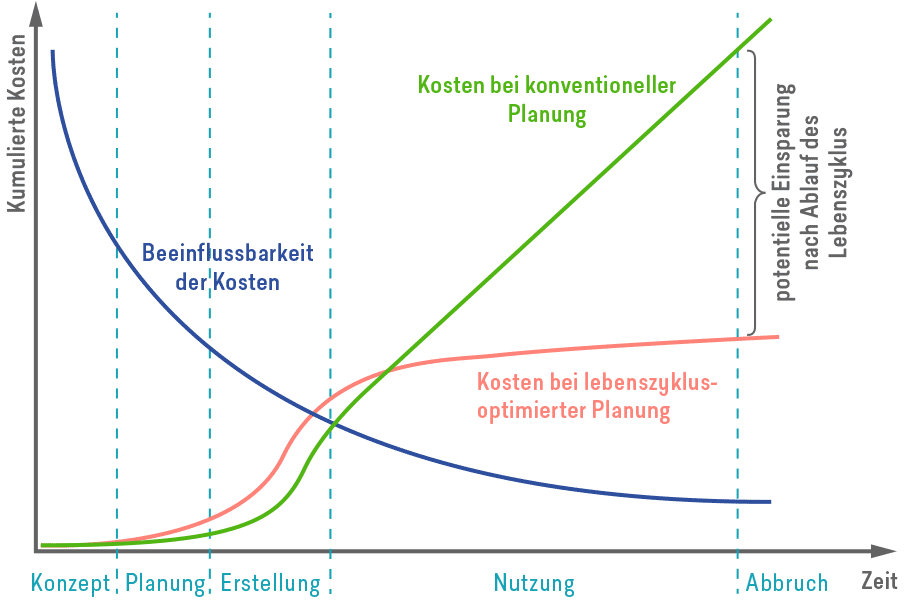Home builders often find out after just a few years that the operating and maintenance costs of their beloved home exceed the expenses for planning and construction. The aim of life cycle costing is to minimize the consumption of energy and resources in all phases of the life cycle and to put as little strain on the ecosystem as possible. In this article we will show you how to do this.
the essentials in brief
- The life cycle costs of a building – from planning, through construction, operation and maintenance to demolition and recycling – can be recorded using the life cycle costing method.
- With 70-85%, the usage costs make up a large part of the total costs of a building and therefore play a central role in the life cycle cost calculation.
- Individual user behavior, unforeseeable developments and short-term market trends pose challenges when calculating operating and maintenance costs.
As so often in life, when building a house you are often faced with a decision between two or more manufacturers, companies or products. In addition to differences in quality, service offers and personal gut feeling, the house construction costs are a decisive criterion in the selection process for many builders. It is often not easy to say which product is cheaper in the long run. For example, while one option scores with low acquisition costs, but high operating and disposal costs, the other option promises low follow-up costs, which are overshadowed by the high acquisition costs. Nevertheless, in most cases it is worth investing in the more expensive variant with low follow-up costs, because this often creates a balance – the so-called trade-off. This trade-off can only be recognized by looking at the life cycle.
Holistic approach to life cycle costs through life cycle costing
As early as the 1960s, the concept of life cycle costing or life cycle costing (LCC) was used to assess the profitability of large investments in the construction and military sectors. The cost management method considers the entire product life cycle – from the initial idea to disposal. With regard to the life cycle of a building, all costs that arise between planning and demolition (e.g. construction, use, maintenance, repair or renovation costs as well as disposal or recycling costs) are taken into account. The LCC approach not only brings advantages for providers, but also for the customers: Lower costs for development, design, production and logistics as well as for procurement, operation, maintenance and recycling ensure that the wallet is relieved on both sides. Manufacturers should therefore not only pay attention to their own costs but also to those of their customers. Guarantees or return or recycling options reduce the repair or disposal costs incurred, for example.
Planning and construction costs are often just the tip of the iceberg
The planning , realization, use and dismantling of buildings cause costs, energy and material flows – with corresponding consequences for the environment. Due to the long service life of a building, however, the operating costs make up the largest part of the total costs at around 70-85%. But how and when can the operating and life cycle costs in general be influenced? The chances of this are best at the beginning of planning. It is precisely at this early stage that important cost and quality decisions are made that affect the entire life cycle of the building. Whether the choice of location, the cubature of the building, the configuration of the floor plan or the ease of cleaning and durability of the floor – every decision entails costs that must be considered in advance. With the method of computer-aided life cycle cost planning, different variants can be compared and all expenses incurred during construction, use and demolition can be optimized. The result of this analysis method is a monetary amount that has been converted to the usable or gross floor area and is therefore comparable.

Investing in energy-efficient home technology pays off
When it comes to the question “How much does a house cost?”, not only the planning and construction, but also the equipment of a house play a major role. Automatic gate openers, self-regulating room heating systems, modern alarm systems, app-controlled pre-heating of the in-house sauna – the mechanization of buildings is constantly increasing. The reasons for this lie in the increasing demands for supply and disposal, as well as protection and safety, as well as comfort and coziness. In combination with rising energy prices, this causes high usage costs. As operating costs play an increasingly important role in the selection of building services systems, some manufacturers of pumps, ventilation, air conditioning, elevators and other building services have been offering calculation tools for some time, which can be used to calculate the medium and long-term advantages of energy-efficient devices and systems based on life cycle cost calculations. Although these tools do a good job when comparing product, system or building variants, one should not underestimate the input effort, especially when comparing buildings.
The Limits of Life Cycle Costing
Due to the rising energy costs and the growing awareness of sustainability in our society, the LCC observation model is increasingly coming into focus in the construction industry. It offers high savings potential in terms of costs and resources and is now also an important part of many sustainability certifications. It not only relieves your wallet, but also the environment. While the planning, acquisition and recycling costs can usually be forecast relatively accurately, the operating and maintenance costs are difficult to predict. Working hours, user numbers, cleaning cycles, ventilation and heating behavior – all of these influencing factors can only be estimated approximately and depend on individual user behavior. However, the rule of thumb is: One monetary unit increase in costs in product planning, product development and construction saves eight to ten monetary units in production and sales costs. Future price and interest rate developments as well as market trends represent further uncertain parameters when estimating the usage costs. Even with regard to the “soft” evaluation criteria, such as comfort and comfort, LCC programs have hitherto reached their limits.



